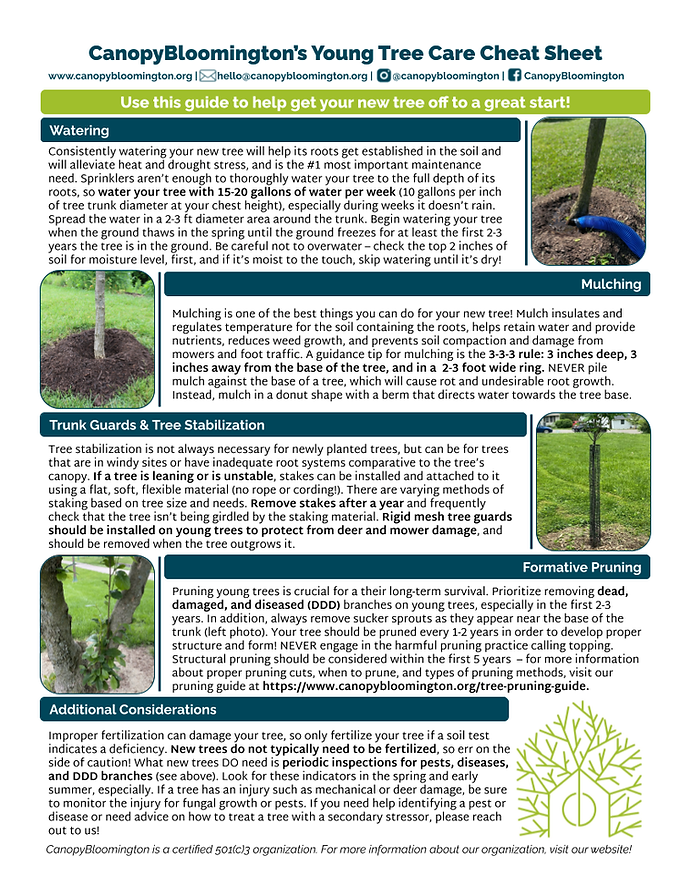
Young Tree Care
Taking care of young trees is the best way to ensure their survival starting with watering, mulching, tree stabilization, and formative pruning. Hover over each image below to learn more.
Consistently watering your new tree will help its roots get established in the soil and will alleviate heat and drought stress.
Water your tree with 15-20 gallons of water per week especially during weeks it doesn’t rain. Spread the water in a 2-3 ft diameter area around the trunk. Begin watering your tree when the ground thaws in the spring until the ground freezes for at least the first 2-3 years the tree is in the ground. Be careful not to overwater – check the top 2 inches of soil for moisture level, first, and if it’s moist to the touch, skip watering until it’s dry!

Watering
Consistently watering your new trees will help....
Tree stabilization is not always necessary for newly planted trees, but can be for trees that are in windy sites or have inadequate root systems comparative to the tree’s canopy. If a tree is leaning or is unstable, stakes can be installed and attached to it using a flat, soft, flexible material (no rope or cording!). There are varying methods of staking based on tree size and needs. Remove stakes after a year and frequently check that the tree isn’t being girdled by the staking material. Rigid mesh tree guards should be installed on young trees to protect from deer and mower damage, and should be removed when the tree outgrows it.

Formative Pruning
I'm a paragraph. Click here to add your own text and edit me. It's easy.
Mulching is one of the best things you can do for your new tree! Mulch insulates and regulates temperature for the soil containing the roots, helps retain water and provide nutrients, reduces weed growth, and prevents soil compaction and damage from mowers and foot traffic.
A guidance tip for mulching is the 3-3-3 rule: 3 inches deep, 3 inches away from the base of the tree, and in a 2-3 foot wide ring. NEVER pile mulch against the base of a tree, which will cause rot and undesirable root growth. Instead, mulch in a donut shape with a berm that directs water towards the tree base.

Mulching
I'm a paragraph. Click here to add your own text and edit me. It's easy.
Improper fertilization can damage your tree, so only fertilize your tree if a soil test indicates a deficiency. New trees do not typically need to be fertilized, so err on the side of caution!
What new trees DO need is periodic inspections for pests, diseases, and DDD branches. Look for these indicators in the spring and early summer, especially. If a tree has an injury such as mechanical or deer damage, be sure to monitor the injury for fungal growth or pests. If you need help identifying a pest or disease or need advice on how to treat a tree with a secondary stressor, please reach out to us or a certified arborist!

Additional
Information
I'm a paragraph. Click here to add your own text and edit me. It's easy.
Tree stabilization is not always necessary for newly planted trees, but can be for trees that are in windy sites or have inadequate root systems comparative to the tree’s canopy. If a tree is leaning or is unstable, stakes can be installed and attached to it using a flat, soft, flexible material (no rope or cording!). There are varying methods of staking based on tree size and needs. Remove stakes after a year and frequently check that the tree isn’t being girdled by the staking material. Rigid mesh tree guards should be installed on young trees to protect from deer and mower damage, and should be removed when the tree outgrows it.

Tree Guards & Tree Stabilization
I'm a paragraph. Click here to add your own text and edit me. It's easy.

